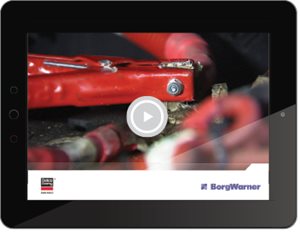When there are starter issues, you may think about doing a current draw test to pinpoint the issue. Yet, on a class 8 truck, a current draw test may not reveal what you need to know to fix your cranking problem. Plus, on these vehicles, a current draw test is more involved and time-intensive. And perhaps most frustrating—you often don’t get an accurate reading.
That’s why the BorgWarner technical team recommends another diagnostic route to identify the issue and fix the cranking problem.
STEP 1: Identify the symptoms.
With a cranking system, symptoms are divided into one of three possible troubleshooting categories:
- Click — No-Crank (solenoid clicks but starter doesn’t crank)
- No-Click — No-Crank (solenoid doesn’t click/starter doesn’t crank)
- Slow Crank (starter cranks, but engine RPM slow to start vehicle)
Once you’ve identified which problem you’re dealing with, then you can start to remedy it.
STEP 2: Charge the batteries and perform a battery load test on the battery bank.
If the load test fails, then individually test each battery and replace any faulty ones.
STEP 3: Perform a voltage drop test on the starter main cables.
The starter voltage drop should be less than .5 volts drop total on the cranking circuit. This is an important step and often the cause of a slow crank complaint. Yet, voltage drop also is a leading cause of click or no-click complaints because almost every vehicle manufacturer uses the heavy positive post located on the starter solenoid as a place to pick up the current used to supply the control circuit.
STEP 4: Address the specific issue.
- If the battery and cable checks are within specification and the vehicle still cranks slowly, then it’s a slow cranking problem and it’s time to replace the starter.
- For click-no crank issues, check the control circuit. If the starter does not contain an Integrated Magnetic Switch, or IMS, then a voltage drop test needs to be performed on the vehicle control circuit. If the starter does have an IMS switch function, then the technician will have to verify that the vehicle’s control circuit is providing voltage to
the starter’s IMS.
- Just like the slow cranking complaint, if all systems have been checked, and the starter is found to be the cause, the ring gear also should be inspected for damage that could cause future harm to the starter.
Our latest tech tip video explains how to diagnose starter cranking problems. Watch it on the Delco Remy YouTube channel at
https://youtu.be/9XPQAi7qwok

